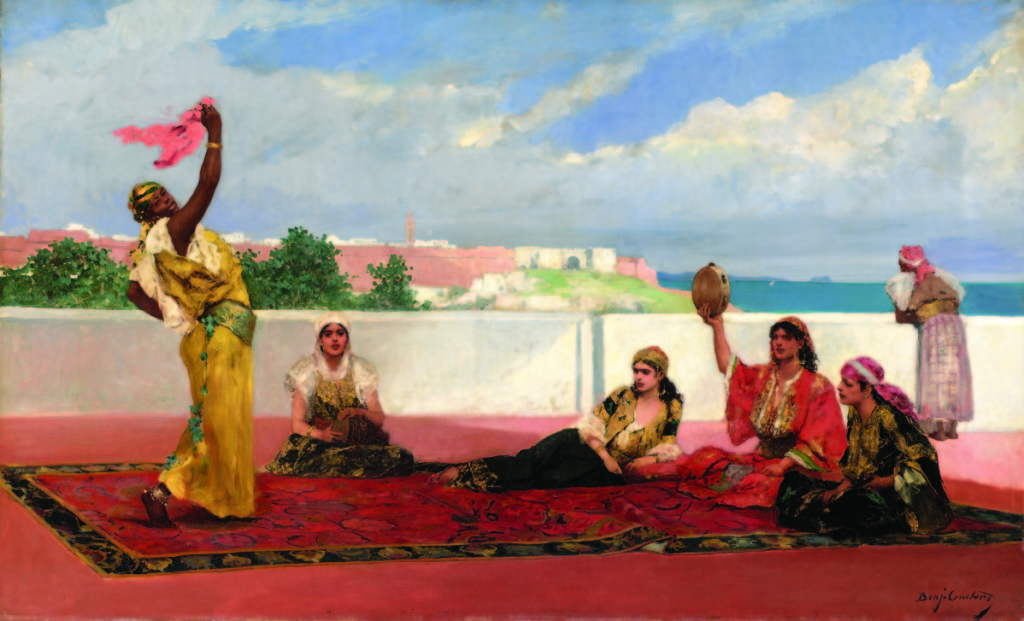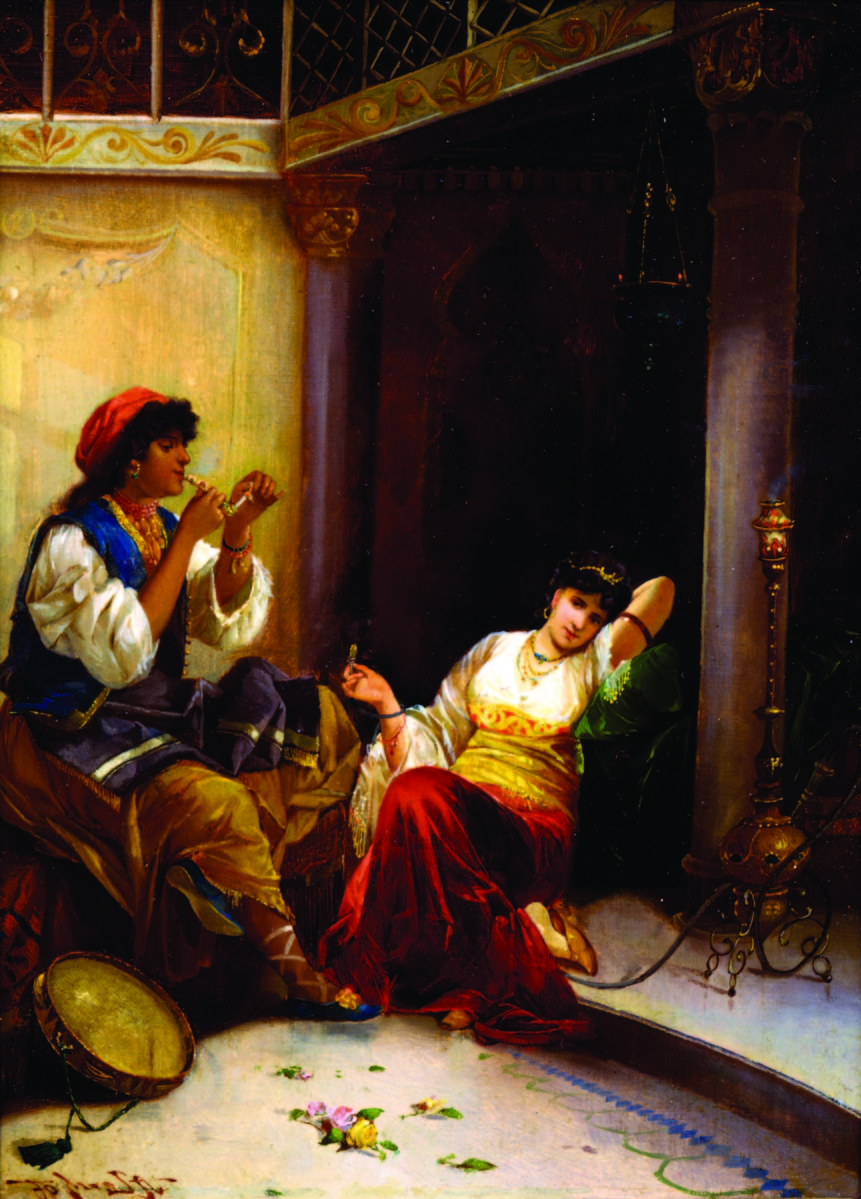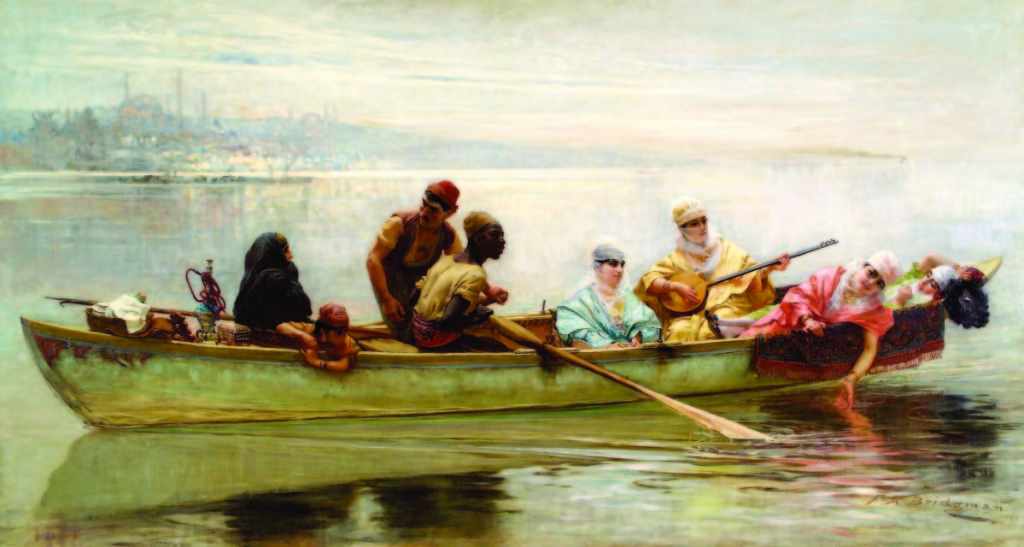
“The Scarf Dance” by Jean Joseph Benjamin Constant (French, 1845–1902), undated. Frances Lehman Loeb Art Center, Vassar College, Poughkeepsie, N.Y., gift of Mrs Elon H. Hooker (Blanche Ferry, Class of 1894).
PALM BEACH, FLA. – For centuries, the Muslim harem, a favorite subject of Orientalist artists, has evoked images of beauty, sensuality and wealth. The subject especially captured the imaginations of Gilded Age artists and collectors.
“Harem: Unveiling the Mystery of Orientalist Art,” on view at the Flagler Museum through April 22, explores the West’s fascination with this exotic subject through approximately 50 works of art and artifacts.
The harem – derived from the Arabic haram, meaning “something forbidden” – was a private domestic space in Muslim households, reserved solely for wives, female relatives, children and servants. It was forbidden to nearly all men and Westerners. Such restrictions, however, only served to heighten curiosity about harem life in the West. Depictions of harems were in great demand among Gilded Age collectors of Orientalist art in America and Europe. Henry Flagler owned at least six paintings of harem scenes, which are featured in the exhibit.

“The Harem Beauties” by Carl Libert August Lentz (German, 1827–1898), 1868. Dahesh Museum of Art, New York
Throughout the Eighteenth-Nineteenth Centuries, the cultures of the Middle East and North Africa fascinated Westerners, who often found their customs and lifestyles strange yet appealing. Travelers on the Grand Tour commonly collected photographs of veiled women and fortified harems as souvenirs. Firsthand accounts of the customs and lifestyles of the harem were rare, but newspaper and book publishers in Europe and America produced many narratives and news features about these cultures and mysterious harem traditions.
While the rare traveler and artist did obtain access to the harem and could relay fact-based accounts, by the late Nineteenth Century sensational and often salacious stories about harem activities became prevalent in Western popular culture. A colorful erotic mythology developed around the harem, which was variously portrayed as a den for the sultan’s sexual pleasure, a prison for abducted slaves or a target of derision. Depictions of Muslim women also varied greatly, from caring mothers and strong women to sexy odalisques that existed only for the pleasure of their master.
Images of alluring harem odalisques such as French painter Jean-Léon Gérôme’s “Odalisque,” not dated (Appleton Museum) and American Addison T. Millar’s “Entrance to a Harem,” circa 1880-1892 (Lyndhurst), simultaneously met the demand for such depictions and fueled the mythology of the harem.
By the early Twentieth Century, such characterizations were pervasive in American popular culture, appearing in advertising, cartoons, music and motion pictures. Mythologized and critical representations of the harem and Muslim women reached a peak in America at Chicago’s World’s Columbian Exposition. Turkish and Algerian villages, a Moorish palace, and “A Street in Cairo” were among the most popular attractions, presenting exhibits such as a Moorish harem and introducing the belly dance to a scandalized public. These displays largely presented the participants as racially inferior and subjects of ridicule.
The reality of the Muslim harem was quite different, however. It was essentially a family home, a place to raise royal children within a controlled, close-knit family setting, and for women to live unveiled, without concern for being seen by outsiders. While racy versions of harem life may have dominated popular culture, there was also great interest in more realistic depictions of this private realm.
Numerous articles were written describing the private lives of the families of the sultans, and artists created realistic and respectful images of Muslim women and families. Such depictions of harem life by French artists include “Woman and Little Girl of Constantine with a Gazelle” by Théodore Chasseriéau, 1849 (Museum of Fine Arts, Houston) and Jean Joseph Benjamin Constant’s “The Scarf Dance,” 1845-1902 (Frances Lehman Loeb Art Center, Vassar College, N.Y.).

“Morning on the Bosphorus,” Frederick Arthur Bridgman (American, 1847–1928), undated. Flagler College, St Augustine, Fla.
Many others took a more ethnographic interest in Muslim cultures. Artists, photographers and scholars traveled to the Middle East and North Africa, studying the people, their customs, clothing and homes and depicting them in a sensitive manner. Austro French painter Rudolf Ernst’s “Occupations of the Seraglio,” circa 1885 (Syracuse University Art Galleries) and American Frederick Arthur Bridgman’s “Morning on the Bosphorus,” undated (Flagler College) reveal deep interest in the details of harem life and its material culture.
Organized by the Flagler Museum, this exhibition features paintings, drawings, sculptures, rare books, period photographs, fine art prints and ephemera, on loan from public institutions and private collections.
Tracy Kamerer, the Flagler Museum’s chief curator, will present a gallery talk on “Harem” on Tuesday, February 21, at 12:15 pm. She will discuss the Gilded Age interest in harems and the artists who depicted them. The talk is free but space is limited, RSPV at 561-655-2833, extension 10.
The museum is at 1 Whitehall Way. For information, www.flaglermuseum.us or 561-655-2833.













